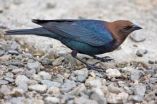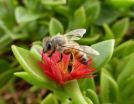(Press-News.org) An image of a galaxy cluster taken by the NASA/ESA Hubble Space Telescope gives a remarkable cross-section of the Universe, showing objects at different distances and stages in cosmic history. They range from cosmic near neighbours to objects seen in the early years of the Universe. The 14-hour exposure shows objects around a billion times fainter than can be seen with the naked eye.
This new Hubble image showcases a remarkable variety of objects at different distances from us, extending back over halfway to the edge of the observable Universe. The galaxies in this image mostly lie within about five billion light-years of us, but the field also contains objects that are both closer and more distant.
Studies of this region of the sky have shown that many of the objects that appear to lie close together may actually be billions of light-years apart. This is because several groups of galaxies lie along our line of sight, creating something of an optical illusion. Hubble's cross-section of the Universe is completed by distorted images of galaxies in the very distant background.
These objects are sometimes distorted due to a process called gravitational lensing, an extremely valuable technique in astronomy for studying very distant objects [1]. This lensing is caused by the bending of the space-time continuum by massive galaxies lying close to our line of sight to distant objects.
One of the lens systems visible here is called CLASS B1608+656, which appears as a small loop in the centre of the image. It features two foreground galaxies distorting and amplifying the light of a distant quasar. The light from this bright disc of matter, which is currently falling into a black hole, has taken nine billion years to reach us -- two thirds of the age of the Universe.
As well as CLASS B1608+656, astronomers have identified two other gravitational lenses within this image. Two galaxies, dubbed Fred and Ginger by the researchers who studied them, contain enough mass to visibly distort the light from objects behind them. Fred, also known more prosaically as [FMK2006] ACS J160919+6532, lies near the lens galaxies in CLASS B1608+656, while Ginger ([FMK2006] ACS J160910+6532) is markedly closer to us. Despite their different distances from us, both can be seen near to CLASS B1608+656 in the central region of this Hubble image.
To capture distant and dim objects like these, Hubble required a long exposure. The image is made up of visible and infrared observations with a total exposure time of 14 hours.
INFORMATION:
Notes
[1] Gravitational lensing can amplify the light coming from distant objects, enabling telescopes like Hubble to see objects that would otherwise be too faint and far away. This effect will be exploited during the Frontier Fields observing campaign in the near future, which aims to combine the power of Hubble with the natural amplification caused by strong gravitational lensing of distant galaxy clusters, to study the past Universe.
More information
The Hubble Space Telescope is a project of international cooperation between ESA and NASA.
The image was spotted by contestant Adam Kill in the 2012 Hubble's Hidden Treasures competition. Hidden Treasures invited members of the public to search Hubble's science for the best overlooked images that have never been seen by a general audience. This image of CLASS B1608+656 has been well- studied by scientists over the years, but this is the first time it has been published in full online.
Links
Images of Hubble - http://www.spacetelescope.org/images/archive/category/spacecraft/
Hubble's Hidden Treasures - http://www.spacetelescope.org/hiddentreasures
Contacts
Georgia Bladon
Hubble/ESA
Garching, Germany
Tel: +49-89-3200-6855
Email: gbladon@partner.eso.org
A cross-section of the universe
2014-04-17
ELSE PRESS RELEASES FROM THIS DATE:
Researcher looks at public perceptions around newborn testing
2014-04-17
TORONTO, April 17, 2014—While 94 per cent of Canadians surveyed said they would participate in public health programs that screen newborns for a specific number of genetic conditions, only 80 per cent said they would be willing to participate in screening that would sequence their newborns' genomes.
Most newborns in North America have a "heel prick test" in their first day or two of life in which a tiny amount of blood is taken from their heels and tested for about five to 54 conditions, depending on the state or province. Some conditions commonly tested for include cystic ...
Adrenaline does little to increase patient's survival after cardiac arrest
2014-04-17
TORONTO, April 17, 2014— Giving patients adrenaline after they suffer a cardiac arrest outside of a hospital does not increase their prospects of surviving long-term, according to new research conducted at St. Michael's Hospital.
"The vast number of patients who have a cardiac arrest get adrenaline, which has been the drug recommended in treating cardiac arrest for decades," said Dr. Steve Lin, an emergency physician and trauma team leader at St. Michael's. "Yet, despite advances in medical treatment, long-term survival rates of patients who suffer a cardiac outside a ...
Animal study provides first evidence that gel can prevent multiple virus transmission in vagina/rectum
2014-04-17
NEW YORK (17 April 2014)— Population Council scientists and their partners have found that their proprietary microbicide gel is safe, stable, and can prevent the transmission of multiple sexually transmitted infections (STIs) in both the vagina and rectum in animals: HIV, herpes simplex virus 2 (HSV-2), and human papillomavirus (HPV). The USAID-funded study also provides the first data that the gel is effective against multiple strains of HIV, and has a window of efficacy in the vagina against all three viruses of at least eight hours prior to exposure. A Phase 1 safety ...
Wireless power transfer achieved at 5-meter distance
2014-04-17
Daejeon, Republic of Korea, April 17, 2014 – The way electronic devices receive their power has changed tremendously over the past few decades, from wired to non-wired. Users today enjoy all kinds of wireless electronic gadgets including cell phones, mobile displays, tablet PCs, and even batteries. The Internet has also shifted from wired to wireless. Now, researchers and engineers are trying to remove the last remaining wires altogether by developing wireless power transfer technology.
Chun T. Rim, a professor of Nuclear & Quantum Engineering at KAIST, and his team ...
Fear of the cuckoo mafia
2014-04-17
This news release is available in German. If a restaurant owner fails to pay the protection money demanded of him, he can expect his premises to be trashed. Warnings like these are seldom required, however, as fear of the consequences is enough to make restaurant owners pay up. Similarly, mafia-like behaviour is observed in parasitic birds, which lay their eggs in other birds' nests. If the host birds throw the cuckoo's egg out, the brood parasites take their revenge by destroying the entire nest. Consequently, it is beneficial for hosts to be capable of learning and ...
East African honeybees are safe from invasive pests… for now
2014-04-17
Several parasites and pathogens that devastate honeybees in Europe, Asia and the United States are spreading across East Africa, but do not appear to be impacting native honeybee populations at this time, according to an international team of researchers.
The invasive pests include including Nosema microsporidia and Varroa mites.
"Our East African honeybees appear to be resilient to these invasive pests, which suggests to us that the chemicals used to control pests in Europe, Asia and the United States currently are not necessary in East Africa," said Elliud Muli, senior ...
Drought and fire in the Amazon lead to sharp increases in forest tree mortality
2014-04-17
Ongoing deforestation and fragmentation of forests in the Amazon help create tinderbox conditions for wildfires in remnant forests, contributing to rapid and widespread forest loss during drought years, according to a team of researchers.
The findings show that forests in the Amazon could reach a "tipping point" when severe droughts coupled with forest fires lead to large-scale loss of trees, making recovery more difficult, said Jennifer Balch, assistant professor of geography, Penn State.
"We documented one of the highest tree mortality rates witnessed in Amazon forests," ...
Classifying cognitive styles across disciplines
2014-04-17
Educators have tried to boost learning by focusing on differences in learning styles. Management consultants tout the impact that different decision-making styles have on productivity. Various fields have developed diverse approaches to understanding the way people process information. A new report from psychological scientists aims to integrate these disciplines by offering a new, integrated framework of cognitive styles that bridges different terminologies, concepts, and approaches.
"This new taxonomy of cognitive styles offers a clear categorization of different types ...
Unraveling the 'black ribbon' around lung cancer
2014-04-17
It's not uncommon these days to find a colored ribbon representing a disease. A pink ribbon is well known to signify breast cancer. But what color ribbon does one think of with lung cancer?
Although white has been identified as the designated color, for many suffering from the disease, black may be the only one they think fits.
A Michigan State University study consisting of lung cancer patients, primarily smokers between the ages of 51 to 79 years old, is shedding more light on the stigma often felt by these patients, the emotional toll it can have and how health providers ...
Some immune cells defend only 1 organ
2014-04-17
Scientists have uncovered a new way the immune system may fight cancers and viral infections. The finding could aid efforts to use immune cells to treat illness.
The research, in mice, suggests that some organs have the immunological equivalent of "neighborhood police" – specialized squads of defenders that patrol only one area, a single organ, instead of an entire city, the body.
Scientists at Washington University School of Medicine in St. Louis have shown that the liver, skin and uterus each has dedicated immune cells, which they call tissue-resident natural killer ...







